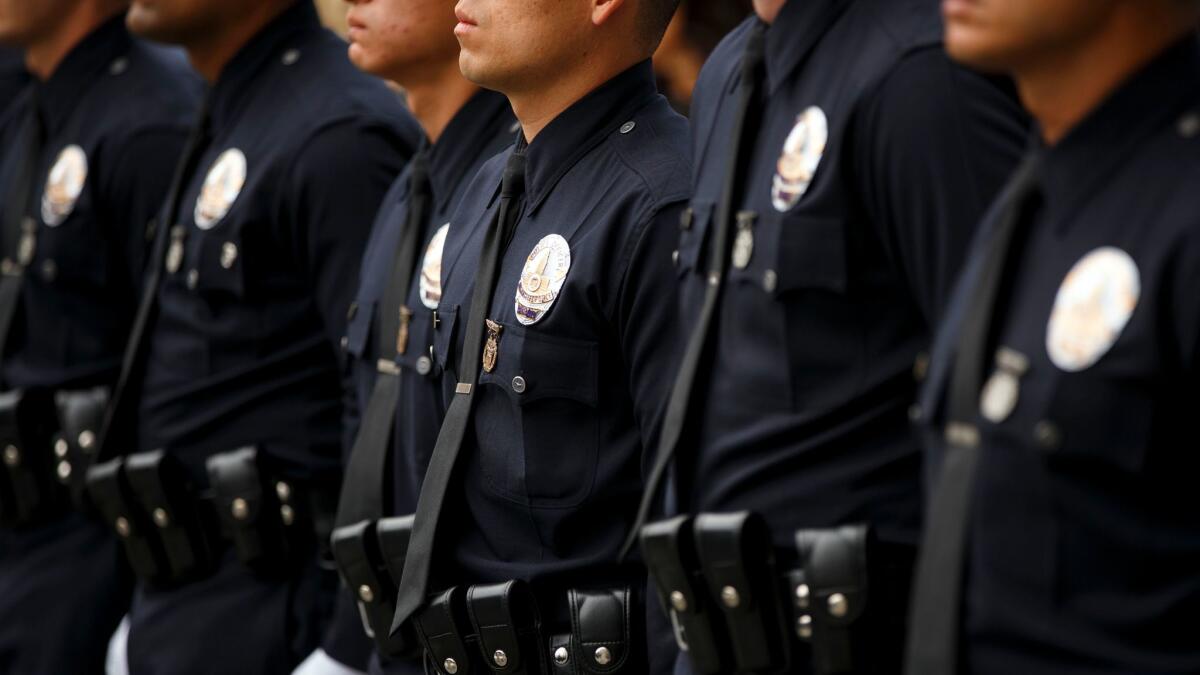Complaints against LAPD rise as body-worn cameras help exonerate officers and prove misconduct

- Share via
Years after spending millions on body-worn cameras, the devices have shown that a small number of Los Angeles police officers committed misconduct while the public levied many false allegations against cops last year, according to a department report.
In 2018, the recordings helped determine officers committed infractions in 56 cases. But police leaders found another 264 complaints against officers “demonstrably false” or resulted in complete exoneration, according to an annual report presented Tuesday to the Los Angeles Board of Police Commissioners. Both of those figures rose significantly from five and 79, respectively, the prior year.
The use of body-worn cameras has been controversial as law enforcement agencies continue to deploy them across the country. While the cameras cost millions to purchase and maintain, citizens and many police leaders say cameras provide transparency in the wake of high-profile incidents.
LAPD Chief Michel Moore said the increases did not surprise him. The department’s 7,000 cameras are holding officers and the public accountable when misconduct allegations are filed, he said.
“It helps both sides of the camera,” Moore said Tuesday after a commission meeting. “The existence of that camera helps answer did the alleged act occur or did it not.”
Overall, the 3,535 complaints filed against the LAPD last year were an 11% increase from 2017 as officers encountered a 6% rise in calls for help. The LAPD also made 2% fewer arrests last year, the report said.
Several members of the police commission, the civilian panel that oversees the department, urged the department to provide more context when it presents reports about annual complaints. Commissioner Dale Bonner said the report provides a lot of raw data, but “it’s very difficult to put the pieces together.”
A chorus of public speakers told commissioners they had no faith in the report.
Greg Akili, a member of Black Lives Matter, said: “If I wanted to hide something, I’d put it in a report like that.”
The LAPD began field testing body-worn cameras in 2014 and eventually deployed more than 7,000. The department collects about 14,000 recordings each day and has accumulated recordings totaling 2.1 million hours.
In 2015, LAPD brass acknowledged that failing to turn on body-worn cameras before a critical incident is a concern and it worked to remedy the issue. But the police union contended that the technology was new and that officers were adjusting to activating cameras, especially in high-stress incidents. Today, Moore said cameras are properly used in 95% of all deployments.
With body-worn cameras fully across the LAPD, Moore said he wants to further use them to make sure officers follow guidelines in routine cases. The department is working with the union to find a way to audit sets of random recordings to look for “procedural justice aspects.”
For example, the department wants to make sure officers aren’t rude and they explain their actions that engender public trust, he said. Moore wants supervisors to review the videos to determine if some officers need additional training.
He called those types of reviews the next evolution of body-worn cameras, not a “gotcha” moment.
“The onset of body worns is changing policing; it’s changing it for the better,” Moore said. “It’s going to improve the public’s trust and understanding for what we ask our officers to do.”
The Los Angeles Police Protective League, which represents rank-and-file officers, said the report shows LAPD “officers continue to provide excellent service in a professional manner and demonstrates the reality that officers fall victim to hundreds of false complaints a year.”
The false complaints waste resources and harm officers careers, the union’s board of directors said in a statement.
The union said it is a strong advocate for effective training that improves officer and community outcomes. “As police officers, we are always looking for opportunities for continuous improvement and quality training,” the statement said.
More to Read
Sign up for Essential California
The most important California stories and recommendations in your inbox every morning.
You may occasionally receive promotional content from the Los Angeles Times.










